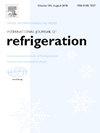室外空调机组轴流风机气动优化研究
IF 3.5
2区 工程技术
Q1 ENGINEERING, MECHANICAL
International Journal of Refrigeration-revue Internationale Du Froid
Pub Date : 2025-03-29
DOI:10.1016/j.ijrefrig.2025.03.031
引用次数: 0
摘要
为了提高室外空调设备中使用的轴流式风机的效率,本研究提出了一种优化叶片形状的方法,即使在轴流式风机易受其周围部件产生的流场影响的情况下也能优化叶片形状。本研究提出了一个多目标优化问题,并采用数值模拟和遗传算法相结合的方法加以解决。在稳定状态下,使用有限体积法计算涉及湍流模型和多参考框架方法的不可压缩纳维-斯托克斯方程组。结果,对于定义为轴功率系数最小化和流量系数最大化的目标函数,得到了帕累托前沿。与假定风扇与周围部件隔离的传统优化方法相比,本研究获得的风扇具有显著特征,尤其是在叶尖周围。此外,实验结果表明,安装在室外机上的优化风扇比基准风扇更高效。所提出的方法能够模拟位于风扇上游区域的部件所产生的尾流,而传统方法并未考虑到这一点。本文章由计算机程序翻译,如有差异,请以英文原文为准。
Aerodynamic optimization of axial fans mounted on outdoor air conditioning units
In order to improve the efficiency of axial fans used in outdoor air conditioning units, this study proposes a method to optimize blade shapes even amid conditions where axial fans are susceptible to the flow field generated by their surrounding components. A multi-objective optimization problem is formulated and solved using a combined numerical simulation and a genetic algorithm. A system of incompressible Navier-Stokes equations involving the turbulence model and a multiple reference frame approach is performed in steady state using the finite volume method. As a result, the Pareto frontier is obtained for the objective functions defined as the minimization of the shaft power coefficient and the maximization of the flow coefficient. Compared to the conventional optimization method which assumes that the fan is isolated from surrounding components, the fan obtained in this study demonstrates remarkable features, especially around the blade tip. In addition, experimental results show that the optimized fan, which is mounted on the outdoor unit, is more efficient than the baseline fan. The proposed method is capable of simulating the wake generated by the components situated in the upstream area of the fan, which has not been taken into account when it comes to the conventional method.
求助全文
通过发布文献求助,成功后即可免费获取论文全文。
去求助
来源期刊
CiteScore
7.30
自引率
12.80%
发文量
363
审稿时长
3.7 months
期刊介绍:
The International Journal of Refrigeration is published for the International Institute of Refrigeration (IIR) by Elsevier. It is essential reading for all those wishing to keep abreast of research and industrial news in refrigeration, air conditioning and associated fields. This is particularly important in these times of rapid introduction of alternative refrigerants and the emergence of new technology. The journal has published special issues on alternative refrigerants and novel topics in the field of boiling, condensation, heat pumps, food refrigeration, carbon dioxide, ammonia, hydrocarbons, magnetic refrigeration at room temperature, sorptive cooling, phase change materials and slurries, ejector technology, compressors, and solar cooling.
As well as original research papers the International Journal of Refrigeration also includes review articles, papers presented at IIR conferences, short reports and letters describing preliminary results and experimental details, and letters to the Editor on recent areas of discussion and controversy. Other features include forthcoming events, conference reports and book reviews.
Papers are published in either English or French with the IIR news section in both languages.

 求助内容:
求助内容: 应助结果提醒方式:
应助结果提醒方式:


